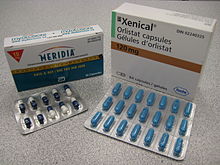
Obesity is a health problem ,with an excess of body fat that imparts health risks and adverse effect on health. Over 20% excess body weight over ideal weight for age,sex and height is considered as health risk .
What are the main causes of obesity ?
Obesity results when intake of calories exceeds the normal limit( normal utilisation by the body ) .This can happen by the following ways -
- Overeating .
- Sedentary lifestyle and lack of activity .
- Genetic factors - recently, two obesity genes have been found : ob gene and its protein product leptin ;& db gene and its protein product leptin receptor .
- Fatty and carbohydrate rich diet than protein rich diet .
- Psychiatric illness - some physical and mental illnesses & the pharmaceutical substances used to treat them can increase the risk of obesity .
- Social status and factors .
- Some infectious agents like viruses ( not clearly understood; study is going on ) .
- Some diseases like hypothyroidism , Cushing's disease , insulinoma and hypothalamic disorders may result to secondary obesity .
How this disorder is classified ?
Obesity can be classified and defined by the Body Mass Index( BMI ) and further evaluated in terms of fat distribution via the waist-hip ratio and total cardiovascular risk factors .
| BMI | Classification |
|---|---|
| < 18.5 | underweight |
| 18.5–24.9 | normal weight |
| 25.0–29.9 | overweight |
| 30.0–34.9 | class I obesity |
| 35.0–39.9 | class II obesity |
| ≥ 40.0 | class III obesity |
Many hormonal mechanisms are involved in the regulation of appetite and food intake ,storage pattern of adipose tissues , and development of insulin resistance . Leptin , ghrelin , insulin , orexin , PYY 3-36 , CCK , adiponectin and adipokinins are the main regulators of obesity .Leptin and ghrelin are considered to be complementary in their influence on appetite . Ghrelin produced by the stomach modulating short term appetite control & leptin is produced by adipose tissues to signal fat storage reserves in the body , and mediates the long term appetite controls . They control appetite through their actions on the CNS . Deficiency in leptin signaling ,either via leptin deficiency or leptin resistance , leads to overeating and may account for some genetic and accuired forms of obesity .
Morphologic features :
1. Increased fat stores in the subcutaneous tissues, skeletal muscles, internal organs(like kidneys , liver and omentum ).
2. Increase in both size and number of fatty tissues ( hypertrophy and hyperplasia ) .
Changes that may occur in various medical aspects :
- Atherosclerosis
- Hypertension
- Type 2 diabetes mellitus
- Hyperlipoproteinaemia
- Fatty liver disease
- Cholelithiasis
- Hypoventilation syndrome
- High blood pressure
- Congestive heart faliure
- Ischemic heart diseases and angina
- Cellulitis
- Acanthosis
- Streach marks
- Complications during pregnancy
- Menstrual disorders
- Infertility
- Obstructive sleep apnoea
- Breast , ovarian , esophageal, liver , gall bladder , cervical, prostatic , kidney , pancreatic , endometrial - cancer .
- Depression
- Social stigmatization
Epidemiology :
Before the 20th century, obesity was a rare medical complication; in 1997 the WHO formally recognized obesity as a global epidemic. As of 2005 the WHO estimates that at least 400 million adults (9.8%) are obese, with higher rates among women than men. The rate of obesity also increases with age at least up to 50 or 60 years old and severe obesity in the United States, Australia, and Canada is increasing faster than the overall rate of obesity. Once considered a problem only of high-income countries, obesity rates are rising worldwide and affecting both the developed and developing world. These increases have been felt most dramatically in urban settings. The only remaining region of the world where obesity is not common is sub-Saharan Africa .

Management & treatment of obesity :
- Behavioural therapy and changing the sedentary lifestyle .
- Controlling the diet .
- Doing regular appropiate exercise .
- Medication - with orlistat or sibutramine by medical professionals .
- Bariatric surgery - as any surgical methods may have complications , surgury is only recommended for severely obese people ( BMI > 40 ) who have failed to lose weight following dietary modification and pharmacological treatment .
References :
- Robbons and Cotran's Pathologic basis of disease - Kumar , Abbass , Fausto ,9th edition
- Textbook Of Pathology - Harsh Mohan , 6th edition
- Harrison's Principles of Internal medicine , 13th edition
- en.wikipedia.org ( for text referances )
- www.wikimedia.org ( for images )
- National library of medicine(NLM), USA govt.
- Centres for Disease Control (CDC) , USA govt.
- Kushner, Robert (2007). Treatment of the Obese Patient (Contemporary Endocrinology). Totowa, NJ: Humana Press. pp. 158
- Kanazawa M, Yoshiike N, Osaka T, Numba Y, Zimmet P, Inoue S (December 2002). "Criteria and classification of obesity in Japan and Asia-Oceania". Asia Pac J Clin Nutr 11 Suppl 8: S732–S73










